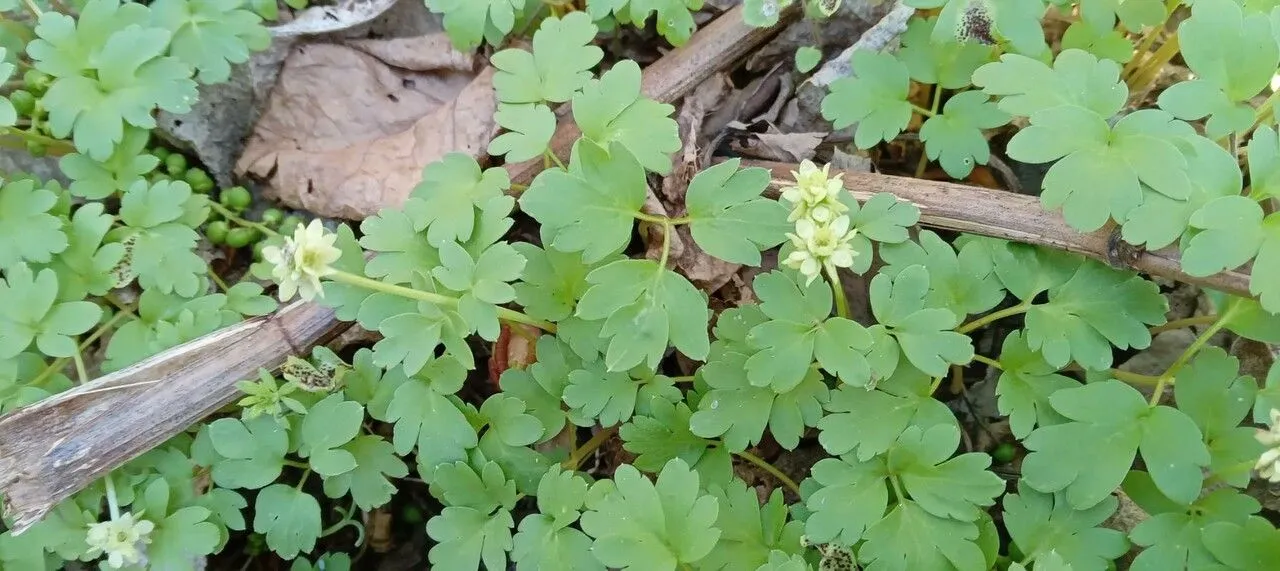
Author: L.
Bibliography: Sp. Pl.: 367 (1753)
Year: 1753
Status: accepted
Rank: species
Genus: Adoxa
Vegetable: False
Observations: Temp. Northern Hemisphere
The Moschatel, scientifically known as Adoxa moschatellina, is an intriguing and rather elusive member of the Viburnaceae family. This perennial herbaceous plant, identifiable by its delicate and ephemeral appearance, predominantly inhabits the temperate regions of the Northern Hemisphere.
One of the distinguishing features of the Moschatel is its unique flowering structure. Unlike many other plants, Adoxa moschatellina produces a small inflorescence consisting of five tiny, greenish-yellow flowers arranged in a cube-like manner. Each humble cluster, often no more than 2 cm in height, is a testament to the plant’s understated elegance and the intricate beauty of nature’s designs.
The leaves of the Moschatel are equally distinctive, typically appearing in a pair of trifoliate leaflets that emerge from a short stalk. Their fresh green hue and finely divided segments add a touch of verdant charm to the forest floors, meadows, and shaded habitats where the plant thrives. As early spring heralds a period of renewal and growth, the Moschatel often appears alongside other early bloomers, enriching the biodiversity of its ecosystem.
Adoxa moschatellina holds a humble charm in its inconspicuous nature, often requiring a keen observer to spot its delicate presence among more dominant flora. Yet, this very subtlety speaks volumes about its adaptability and survival strategies in diverse environments across the Northern Hemisphere. The plant occupies a variety of habitats, from moist woodlands to grasslands, often flourishing in both alkaline and neutral soils.
In 1753, the famed botanist Carl Linnaeus, cited in his monumental work “Species Plantarum,” designated the scientific nomenclature of Adoxa moschatellina, thereby formally recognizing and categorizing this plant within the botanical community. Linnaeus’s documentation has allowed subsequent generations of botanists and plant enthusiasts to study and appreciate the unique characteristics of the Moschatel.
As an important ecological component, the Moschatel provides early-season nectar for pollinators. By existing in symbiosis with its environment, Adoxa moschatellina contributes to the sustenance of various insect species, showcasing the interconnectedness of nature.
In summary, the Moschatel is a remarkable example of nature’s understated beauty, offering a glimpse into the complexity and interdependence of woodland ecosystems. Its unassuming presence and unique floral arrangements make it an interesting subject for both amateur naturalists and seasoned botanists alike.
Dan: desmerurt
Deu: europäisches moschuskraut, moschuskraut
Fra: adoxa, moscatelline, adoxe muscatelle, adoxe musquée, herbe musquée, moschatelline, musquette
Swe: desmeknopp, myskört
Eng: moschatel, moschatel, townhall clock, muskroot, townhall-clock, town-hall clock, townhall clock
Nld: muskuskruid
Sme: deasmeurttas
Cym: anfri, cloc neuadd y dref, diaddurn, mwglys, mwsglys, mwsglys y ddaear, mysglys
En: Moschatel, Muskroot, Townhall-clock, Townhall clock, Moschatel, townhall clock, Town-Hall Clock, Bulbous Fumitory, Common Moschatel, Five-faced Bishop
Ar: أدوكسا
Be: Адокса мускусная
Bg: Мешковица
Zh: 五福花
Kw: Muskles
Cs: Pižmovka mošusová
Da: Desmerurt
Nl: Muskuskruid
Et: Muskuslill
Fi: Tesmayrtti
Fr: Adoxa, Moscatelline, Adoxe muscatelle, Adoxe musquée, Herbe musquée, Moschatelline, Musquette, Adoxe, Fumeterre musquée, Herbe au musc, Moscatelle, Muscatelle, Petite Musquée, Petite Sanicle
De: Moschuskraut, Europäisches Moschuskraut, Bisamkraut, Gemeines Moschuskraut
Hu: Pézsmaboglár
Ga: Moscadal
It: Moscatella
Kk: Байсат
Ko: 연복초
Lt: Muskusinis ūksminas
Mk: Пиженце
Se: Deasmeurttas
No: Moskusurt
Os: Сисли
Fa: آدوکسا مسچاتلینا
Pl: Piżmaczek wiosenny
Ru: Адокса мускусная
Sk: Pižmovka mošusová
Sv: Desmeknopp, Myskört
Zh-tw: 五福花
Tt: Гамбәр чәчәге
Uk: Пижмівка звичайна
Cy: Mwsglys, Anfri, Cloc Neuadd y Dref, Diaddurn, Mwglys, Mwsglys y Ddaear, Mysglys
Taken Apr 27, 2022 by Petr Harant (cc-by-sa)
Taken Apr 27, 2005 by Sylvain Gaudin (cc-by-sa)
Taken Apr 6, 2020 by Peter Vohwinkel (cc-by-sa)
Taken Mar 28, 2021 by alain croibien (cc-by-sa)
Taken Apr 20, 2019 by Heinz Gass (cc-by-sa)
Taken Apr 3, 2016 by Tela Botanica − Yoan MARTIN (cc-by-sa)
Taken Jun 30, 2022 by Lina pourmehr (cc-by-sa)
Taken Mar 5, 2002 by Tela Botanica − Liliane ROUBAUDI (cc-by-sa)
Taken Mar 16, 2022 by huy HO (cc-by-sa)
Taken Apr 27, 2022 by Petr Harant (cc-by-sa)
Taken Apr 10, 2022 by Fabrice Rubio (cc-by-sa)
Taken Mar 16, 2022 by huy HO (cc-by-sa)
Taken Apr 10, 2022 by Fabrice Rubio (cc-by-sa)
Taken Apr 12, 2022 by Joris Moorkamp (cc-by-sa)
Taken Apr 4, 2014 by Tela Botanica − Jacques MARÉCHAL (cc-by-sa)
Taken Apr 5, 2015 by Tela Botanica − Henri SCORDIA (cc-by-sa)
Taken Apr 13, 2012 by Tela Botanica − Hugues HAEFFNER (cc-by-sa)
Taken Apr 18, 2014 by Tela Botanica − Jean-Jacques HOUDRÉ (cc-by-sa)
Taken Apr 18, 2014 by Tela Botanica − Jean-Jacques HOUDRÉ (cc-by-sa)
Taken Nov 27, 2021 by huy HO (cc-by-sa)
Taken May 15, 2010 by Photoflora – Jean-Luc TASSET (©)
Taken Jul 15, 2011 by Photoflora – Jean-Luc TASSET (©)
Taken Jul 15, 2011 by Photoflora – Jean-Luc TASSET (©)
© copyright of the Board of Trustees of the Royal Botanic Gardens, Kew.
© copyright of the Board of Trustees of the Royal Botanic Gardens, Kew.
© copyright of the Board of Trustees of the Royal Botanic Gardens, Kew.
Growth habit: Forb/herb
Ph maximum: 7.5
Ph minimum: 7.0
Light: 4
Atmospheric humidity: 8
Bloom months: [‘mar’, ‘apr’, ‘may’]
Soil nutriments: 6
Family: Myrtaceae Author: (F.Muell.) K.D.Hill & L.A.S.Johnson Bibliography: Telopea 6: 402 (1995) Year: 1995 Status:…
Family: Rubiaceae Author: Pierre ex A.Froehner Bibliography: Notizbl. Bot. Gart. Berlin-Dahlem 1: 237 (1897) Year:…
Family: Sapindaceae Author: Koidz. Bibliography: J. Coll. Sci. Imp. Univ. Tokyo 32(1): 38 (1911) Year:…
Family: Asteraceae Author: A.Gray Bibliography: Pacif. Railr. Rep.: 107 (1857) Year: 1857 Status: accepted Rank:…
Family: Fabaceae Author: Medik. Bibliography: Vorles. Churpfälz. Phys.-Ökon. Ges. 2: 398 (1787) Year: 1787 Status:…
Family: Aspleniaceae Author: (Cav.) Alston Bibliography: Bull. Misc. Inform. Kew 1932: 309 (1932) Year: 1932…